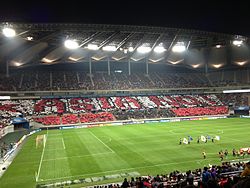Seoul World Cup Stadium
Football stadium in Seoul, South Korea From Wikipedia, the free encyclopedia
Football stadium in Seoul, South Korea From Wikipedia, the free encyclopedia
The Seoul World Cup Stadium (Korean: 서울월드컵경기장), also known as Sangam Stadium, is a stadium used mostly for association football matches. The venue is located in 240, World Cup-ro, Mapo-gu, Seoul, South Korea. It was built for the 2002 FIFA World Cup and opened on November 10, 2001. It is currently the second largest stadium in South Korea after Seoul Olympic Stadium, and is the 2nd largest rectangular stadium in Asia. It was designed to represent the image of a traditional Korean kite.[3] The stadium has a capacity of 66,704 seats, including 816 seats for VIP, 754 seats for press and 75 private Sky Box rooms, each with a capacity for 12 to 29 persons. Due to table seats installation, capacity was reduced from 66,806 seats to 66,704 seats in February 2014. Since the World Cup it has been managed by the Seoul Metropolitan Facilities Management Corporation (SMFMC).[4] FC Seoul moved to the Seoul World Cup Stadium in 2004.
Sangam Stadium | |
 | |
 | |
| Location | 240, World Cup-ro, Mapo-gu, Seoul, South Korea |
|---|---|
| Public transit | Seoul Metropolitan Subway: |
| Operator | Seoul Facilities Management Corporation |
| Capacity | 66,704[1] |
| Surface | Kentucky Bluegrass |
| Construction | |
| Broke ground | October 20, 1998 |
| Opened | November 10, 2001 |
| Construction cost | US $185 million[2] |
| Architect | Ryu Choon-soo |
| Structural engineer | Geiger Engineers |
| Tenants | |
| South Korea national football team FC Seoul (2001-present) | |
| Korean name | |
| Hangul | 서울월드컵경기장 |
|---|---|
| Hanja | 서울월드컵競技場 |
| Revised Romanization | Seoul Woldeukeop Gyeonggijang |
| McCune–Reischauer | Sŏul Wŏldŭk'ŏp Kyŏnggijang |
The Seoul World Cup Stadium, the 2nd largest football-specific stadium in Asia, proudly exhibits its Korean roots. The roof has the unique shape of a traditional Korean kite, is 50 meters high, is supported by 16 masts, and covers 90% of the stadium's seats. Clad with fiberglass fabric and polycarbonate glazing its looks as if it is made out of hanji – traditional Korean paper. At nighttime, illuminations bathe the stadium in a warm, soft light, much like the light shining through the paper of a traditional Korean lamp.[5]
The Seoul World Cup Stadium was one of the venues of the 2002 FIFA World Cup, and held the following matches:
The Seoul World Cup Stadium was the main venue of the 2007 FIFA U-17 World Cup, and held the following matches:
The Seoul World Cup Stadium was the first leg venue of the 2013 AFC Champions League Final.
| FC Seoul | 2–2 | |
|---|---|---|
| Escudero Damjanović |
Report | Elkeson Gao Lin |
Seamless Wikipedia browsing. On steroids.
Every time you click a link to Wikipedia, Wiktionary or Wikiquote in your browser's search results, it will show the modern Wikiwand interface.
Wikiwand extension is a five stars, simple, with minimum permission required to keep your browsing private, safe and transparent.